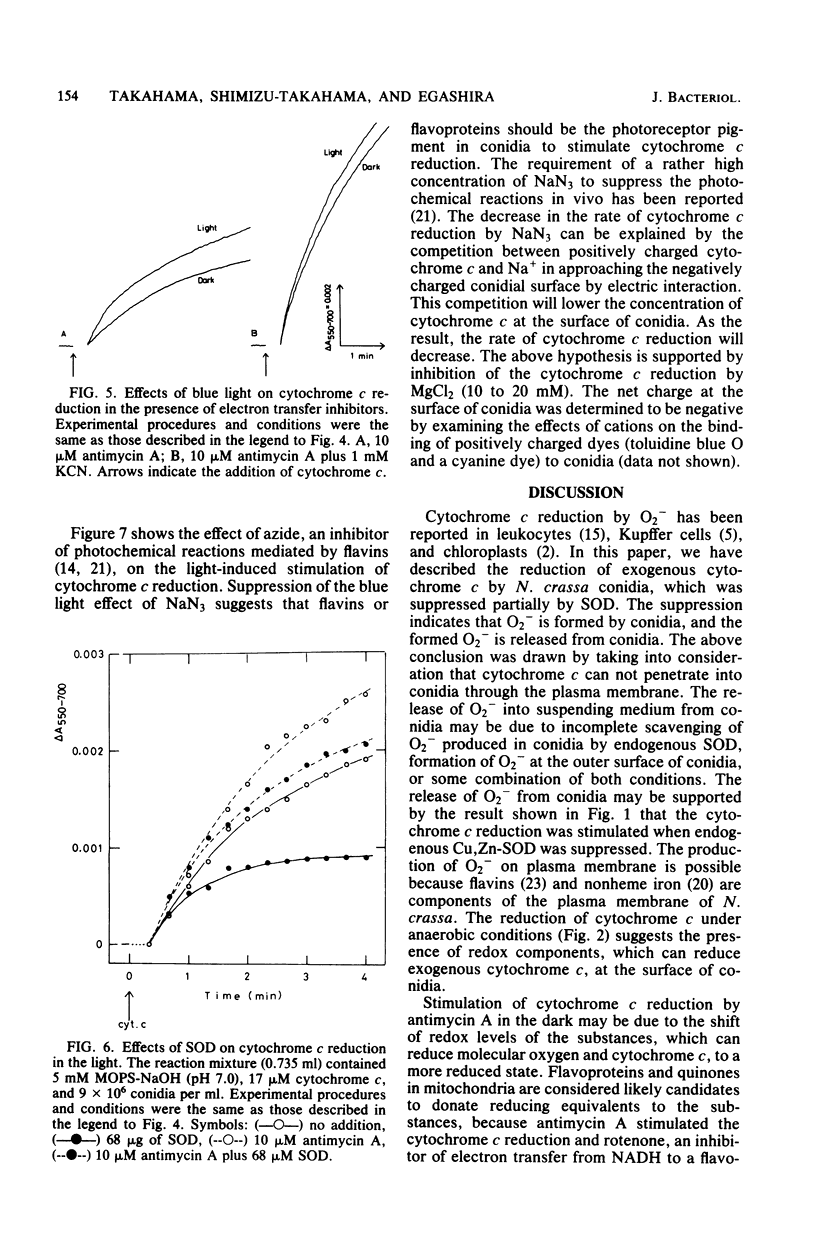Abstract
The reduction of externally added cytochrome c by Neurospora crassa conidia was observed. The reduction was stimulated by antimycin A and suppressed partially by superoxide dismutase. When conidia were treated with diethyldithiocarbamate, which inactivated endogenous superoxide dismutase, the cytochrome c reduction was stimulated. Blue light also stimulated the cytochrome c reduction. Azide, which inhibits photochemical reactions mediated by flavins, suppressed the blue light effect. Superoxide dismutase partially suppressed the cytochrome c reduction in the light. The results suggest that O2(-) participates in the cytochrome c reduction by conidia and the flavins or flavoproteins are candidates for the receptor pigment of blue light to stimulate the cytochrome c reduction. It was also suggested that the redox component(s), which could directly transfer its reducing equivalents to exogenous cytochrome c, was present at the surface of conidia.
Full text
PDF





Selected References
These references are in PubMed. This may not be the complete list of references from this article.
- Aggarwal B. B., Quintanilha A. T., Cammack R., Packer L. Damage to mitochondrial electron transport and energy coupling by visible light. Biochim Biophys Acta. 1978 May 10;502(2):367–382. doi: 10.1016/0005-2728(78)90057-9. [DOI] [PubMed] [Google Scholar]
- Asada K., Kiso K., Yoshikawa K. Univalent reduction of molecular oxygen by spinach chloroplasts on illumination. J Biol Chem. 1974 Apr 10;249(7):2175–2181. [PubMed] [Google Scholar]
- Beauchamp C., Fridovich I. Superoxide dismutase: improved assays and an assay applicable to acrylamide gels. Anal Biochem. 1971 Nov;44(1):276–287. doi: 10.1016/0003-2697(71)90370-8. [DOI] [PubMed] [Google Scholar]
- Bhatnagar R., Schirmer R., Ernst M., Decker K. Superoxide release by zymosan-stimulated rat Kupffer cells in vitro. Eur J Biochem. 1981 Sep;119(1):171–175. doi: 10.1111/j.1432-1033.1981.tb05590.x. [DOI] [PubMed] [Google Scholar]
- Heelis P. F., Parsons B. J., Phillips G. O. The pH dependence of the reactions of flavin triplet states with amino acids. A laser flash photolysis study. Biochim Biophys Acta. 1979 Oct 18;587(3):455–462. doi: 10.1016/0304-4165(79)90449-5. [DOI] [PubMed] [Google Scholar]
- Heikkila R. E., Cabbat F. S., Cohen G. In vivo inhibition of superoxide dismutase in mice by diethyldithiocarbamate. J Biol Chem. 1976 Apr 10;251(7):2182–2185. [PubMed] [Google Scholar]
- Kakinuma K., Yamaguchi T., Kaneda M., Shimada K., Tomita Y., Chance B. A determination of H2O2 release by the treatment of human blood polymorphonuclear leukocytes with myristate. J Biochem. 1979 Jul;86(1):87–95. [PubMed] [Google Scholar]
- Khan A. U. Singlet molecular oxygen from superoxide anion and sensitized fluorescence of organic molecules. Science. 1970 Apr 24;168(3930):476–477. doi: 10.1126/science.168.3930.476. [DOI] [PubMed] [Google Scholar]
- Klebanoff S. J. Role of the superoxide anion in the myeloperoxidase-mediated antimicrobial system. J Biol Chem. 1974 Jun 25;249(12):3724–3728. [PubMed] [Google Scholar]
- McCord J. M., Fridovich I. Superoxide dismutase. An enzymic function for erythrocuprein (hemocuprein). J Biol Chem. 1969 Nov 25;244(22):6049–6055. [PubMed] [Google Scholar]
- Muñoz V., Butler W. L. Photoreceptor Pigment for Blue Light in Neurospora crassa. Plant Physiol. 1975 Feb;55(2):421–426. doi: 10.1104/pp.55.2.421. [DOI] [PMC free article] [PubMed] [Google Scholar]
- Nakagawara A., Minakami S. Generation of superoxide anions by leukocytes treated with cytochalasin E. Biochem Biophys Res Commun. 1975 May 19;64(2):760–767. doi: 10.1016/0006-291x(75)90385-x. [DOI] [PubMed] [Google Scholar]
- Poff K. L., Butler W. L. Absorbance changes induced by blue light in Phycomyces blakesleeanus and Dictyostelium discoideum. Nature. 1974 Apr 26;248(5451):799–801. doi: 10.1038/248799a0. [DOI] [PubMed] [Google Scholar]
- Ramadan-Talib Z., Prebble J. Photosensitivity of respiration in Neurospora mitochondria. A protective role for carotenoid. Biochem J. 1978 Dec 15;176(3):767–775. doi: 10.1042/bj1760767. [DOI] [PMC free article] [PubMed] [Google Scholar]
- Scarborough G. A. The neurospora plasma membrane: a new experimental system for investigating eukaryote surface membrane structure and function. Methods Cell Biol. 1978;20:117–133. doi: 10.1016/s0091-679x(08)62014-2. [DOI] [PubMed] [Google Scholar]
- Schmidt W., Butler W. L. Flavin-mediated photoreactions in artificial systems: a possible model for the blue-light photoreceptor pigment in living systems. Photochem Photobiol. 1976 Jul;24(1):71–75. doi: 10.1111/j.1751-1097.1976.tb06799.x. [DOI] [PubMed] [Google Scholar]
- Schmidt W., Thomson K., Butler W. L. Cytochrome b in plasma membrane enriched fractions from several photoresponsive organisms. Photochem Photobiol. 1977 Oct;26(4):407–411. doi: 10.1111/j.1751-1097.1977.tb07506.x. [DOI] [PubMed] [Google Scholar]
- Schmit J. C., Brody S. Biochemical genetics of Neurospora crassa conidial germination. Bacteriol Rev. 1976 Mar;40(1):1–41. doi: 10.1128/br.40.1.1-41.1976. [DOI] [PMC free article] [PubMed] [Google Scholar]
- Shimizu M., Egashira T., Takahama U. Inactivation of Neurospora crassa conidia by singlet molecular oxygen generated by a photosensitized reaction. J Bacteriol. 1979 May;138(2):293–296. doi: 10.1128/jb.138.2.293-296.1979. [DOI] [PMC free article] [PubMed] [Google Scholar]


